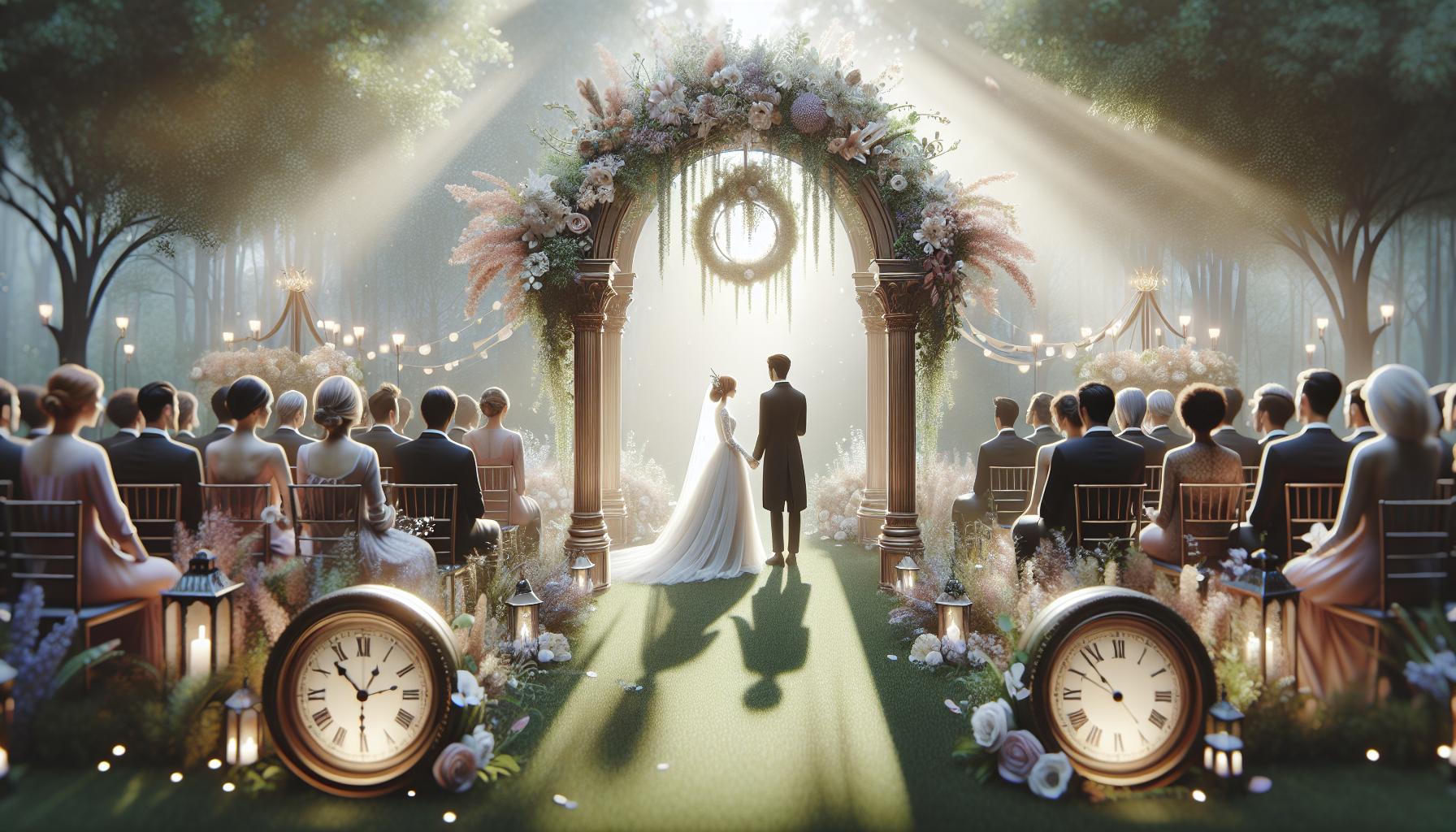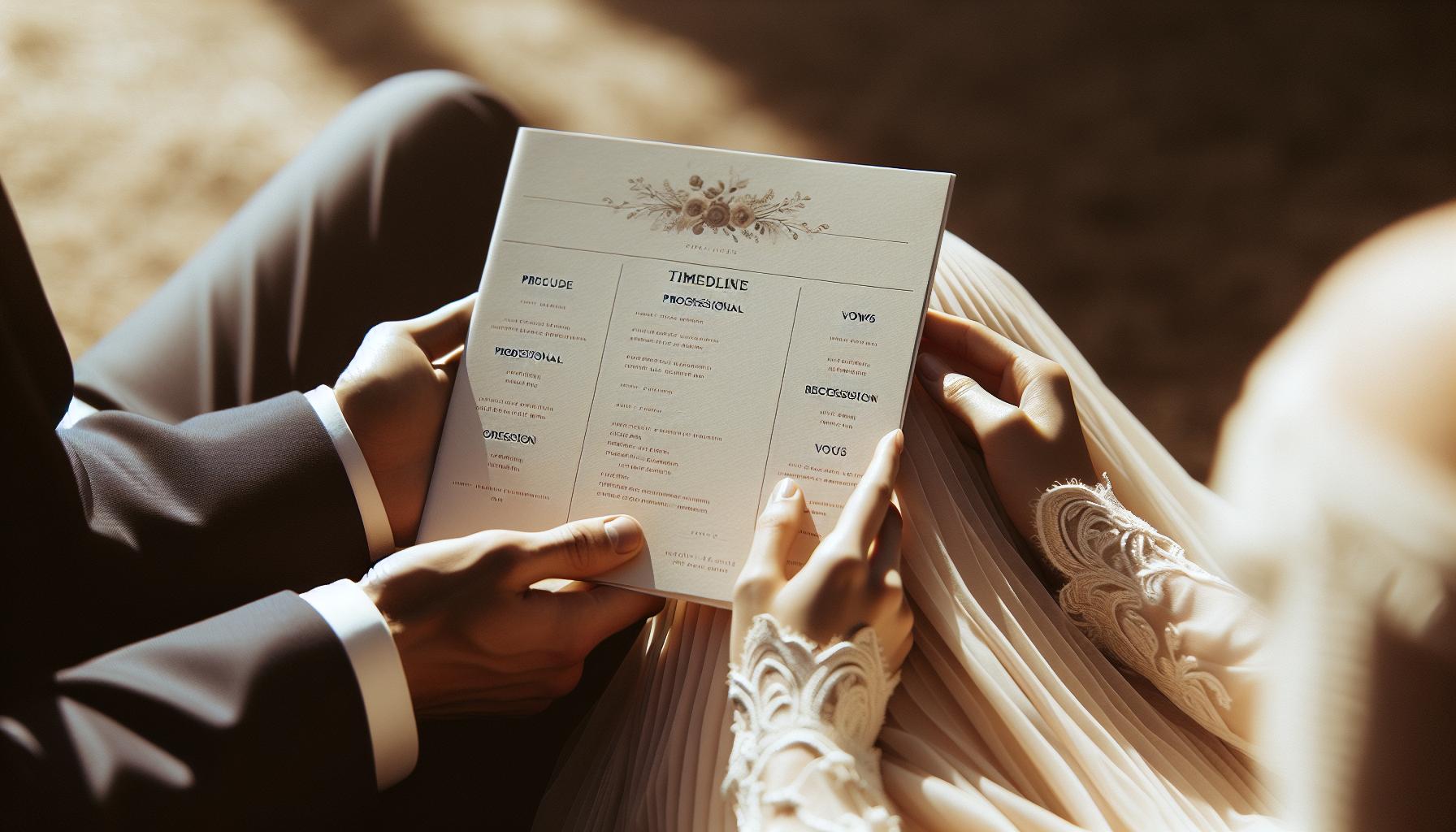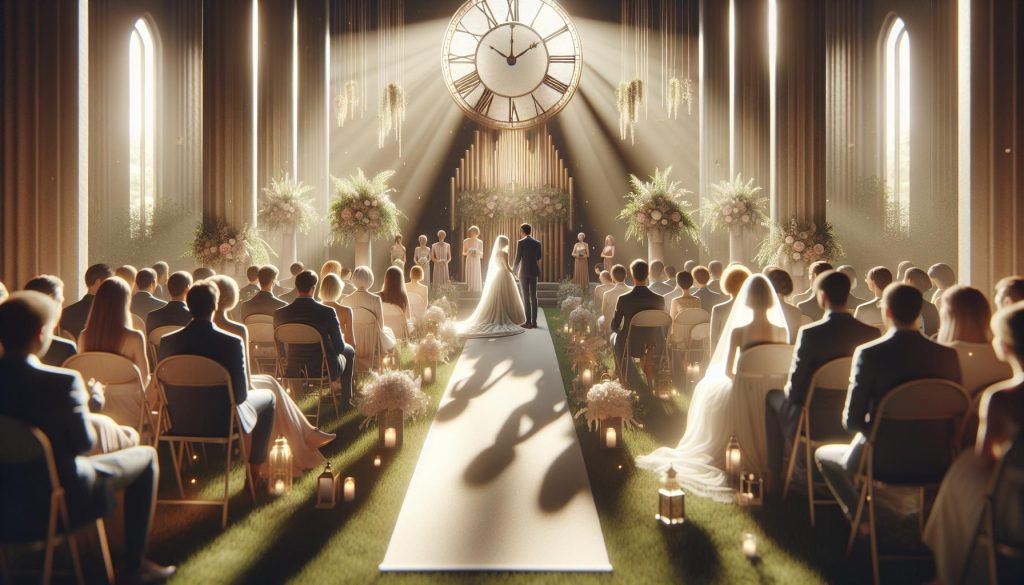Planning your wedding ceremony can be both exhilarating and overwhelming, especially when it comes to timing. Did you know that the average wedding ceremony lasts between 20 to 30 minutes? Understanding how long your ceremony will take is vital for ensuring your celebration flows seamlessly and remains memorable for you and your guests. Whether you’re navigating traditional customs or crafting a personal experience, knowing the timeline allows you to allocate time for heartfelt vows, readings, and special moments without feeling rushed. In this guide, we’ll explore the essential components of a ceremony timeline, providing you with practical insights that will help you create a day that reflects your unique love story. Let’s dive in and make your dream wedding a reality!
Understanding Wedding Ceremony Duration: Key Factors to Consider
Every couple envisions their wedding ceremony as a beautiful reflection of their love, but many may not consider the mechanics behind its duration. The length of a wedding ceremony can vary widely based on several key factors, creating an essential foundation for perfect planning. Understanding these nuances will help you tailor your event to fit your unique vision while ensuring that your special day flows seamlessly.
One of the most significant factors influencing ceremony duration is the preferences and traditions of the couple. Traditional ceremonies often incorporate various readings, music performances, and rituals, which can add to the time required. For example, Catholic weddings typically include multiple elements such as a nuptial mass and the exchange of vows, often extending their total length to about 45 minutes or more. In contrast, secular ceremonies might opt for a more streamlined approach, focusing solely on the vows and rings, which could reduce the duration to 20-30 minutes.
Location also plays a pivotal role. If you’re hosting an outdoor ceremony, consider the timing of natural light, as well as weather conditions, which can affect guest comfort and the overall experience. Ideally, it’s wise to schedule your event to wrap up before sunset, especially if you plan to partake in post-ceremony photography. A general guideline is to start about two hours prior to sunset to optimize both the ceremony and subsequent celebrations, as noted by expert event planners [[3]](https://kaushay.co/2023/05/20/how-to-choose-your-ceremony-time/).
Finally, take into account your guest list size and the mix of traditions represented. Each addition or variation in ceremonial elements can impact timing significantly, so be prepared to make adjustments. With thoughtful preparation and an understanding of these factors, couples can create a memorable ceremony that honors their love while remaining mindful of time management. By embracing both traditional and modern elements, the ceremony can become a beautiful expression of commitment without feeling rushed or overly drawn out.
Typical Wedding Ceremony Length: What to Expect
While planning your wedding, it’s natural to wonder about the duration of the ceremony. Understanding what to expect can help shape this beautiful moment, ensuring it reflects your love story while accommodating your guests’ experience. Typically, wedding ceremonies last anywhere from 20 to 40 minutes, with a sweet spot of around 30 minutes being the most common. This timeframe allows ample room for all essential components without dragging on, keeping the energy of the event joyful and engaging.
To give you an idea of what this time may encompass, here’s a typical breakdown of a 30-minute ceremony:
- Processional (5 minutes): The entrance of the wedding party and the couple.
- Welcome and Opening Remarks (2-3 minutes): The officiant introduces the ceremony.
- Readings or Special Music (5-10 minutes): Selected readings or songs that resonate with the couple.
- Vows (5-10 minutes): The couple shares personal vows, or traditional vows are exchanged.
- Ring Exchange (3-5 minutes): The couple presents and exchanges rings.
- Closing Remarks and Pronouncement (2-3 minutes): The officiant concludes the ceremony with a final blessing and pronouncement.
During this special time, it’s essential to consider the flow of your ceremony. Incorporating both traditional elements-like rituals or readings-and personal touches can make your ceremony unique and memorable. However, keep in mind that each added element can extend the length. For example, if you include a candle lighting or unity sand ceremony, it may add a few extra minutes, possibly bringing the total to 35-40 minutes. Thus, achieving the right balance is key.
Ultimately, your wedding ceremony should feel comfortable and heartfelt, allowing moments of joy and reflection while also embracing your individual style. By thoughtfully planning every aspect, you can create an event that perfectly encapsulates your relationship and honors your journey to this unforgettable day.
Essential Components of a Ceremony Timeline
Weddings are a celebration of love, and your ceremony is the heart of that celebration, marking the start of your journey together. Crafting an effective timeline for your ceremony ensures that every moment feels intentional and meaningful. By understanding vital components, you can create an atmosphere that captures the essence of your relationship while keeping the day running smoothly.
Every wedding ceremony generally includes essential segments, each serving a unique purpose that enhances the experience for both the couple and the guests.
- Processional: The moment the wedding party and couple walk down the aisle is magical. Allocate about 5 minutes for this, setting a tone of anticipation and joy as everyone takes their place.
- Welcome and Opening Remarks: Typically lasting 2-3 minutes, these initial words from your officiant establish the ceremony’s theme and welcome guests, creating a warm environment.
- Readings or Special Music: Choose meaningful readings or songs that resonate with your love story. This part can range from 5-10 minutes, offering a moment for personal reflection.
- Vows: Dedicate around 5-10 minutes for this deeply personal exchange, whether you’re sharing traditional vows or writing your own. This is the emotional core of the ceremony.
- Ring Exchange: Lasting about 3-5 minutes, this moment symbolizes your commitment to each other, visually and verbally. It’s a powerful ritual that anchors the ceremony.
- Closing Remarks and Pronouncement: In the final 2-3 minutes, your officiant will conclude the ceremony with blessings and officially announce your union, leading into joyful celebration.
Being aware of the time each segment takes can help you sprinkle in additional elements, such as cultural rituals or personal touches, without overstretching your timeline. For instance, incorporating a unity ceremony-like a candle lighting or sand pouring-might enhance the emotional depth but could extend the total duration by an extra 5-10 minutes.
To ensure that the ceremony flows seamlessly, consider rehearsing the order with your officiant and wedding party. This preparation will give you confidence and allow for a naturally rhythmic progression of events. Remember, every couple is unique, and your timeline should reflect your style and the love story you’re telling. With thoughtful consideration and planning, your wedding ceremony can be an unforgettable experience that resonates with everyone present.
Customizing Your Ceremony: Traditional vs. Modern Elements
Crafting a wedding ceremony is an art that beautifully blends tradition with personal flair, allowing couples to express their unique love story. As you explore how traditional elements can harmonize with modern twists, consider what resonates most with your identity as a couple. This is not just about adhering to age-old customs; it’s about creating an unforgettable experience that reflects who you are together.
When contemplating traditional components, think about elements such as the processional order, which often includes family members followed by the wedding party and the couple themselves. This moment sets the stage for the ceremony, and incorporating live music, whether classical strings or a beloved song, can add extra emotional depth. Many couples choose to include a unity ceremony, like lighting a unity candle or pouring sand, which serves as a beautiful symbol of their union. However, allow flexibility to modernize these practices by incorporating personal anecdotes or unique rituals meaningful to you.
In contrast, modern elements allow for an innovative approach. Consider mingling casual, light-hearted moments amidst the ceremony’s traditional structure. Write your own vows to convey the depth of your commitment; sharing personal stories or promises makes this segment deeply personal and engaging. Another approach is to create an interactive experience for guests, such as having them participate in a group blessing or sharing stories of their own love experiences.
Ultimately, the blend of traditional and modern elements enhances the ceremony’s unique identity, ensuring it is more than just an event but a reflective celebration of your love. Embrace the process as an opportunity to reflect on your relationship and celebrate both your individuality and shared values. Each decision, from musical selections to vow writing, should resonate with the love story you are telling, creating a memorable experience for both you and your guests.
Tips for Planning an Efficient Ceremony Flow
Creating a seamless flow for your wedding ceremony is essential to ensure that every moment feels special while keeping the timing purposefully engaged. Efficient planning not only keeps your guests entertained but also maintains the emotional weight of the occasion. A well-timed ceremony allows you to encompass all desired elements-vows, readings, and rituals-without the risk of overstaying your welcome with the audience. Consider these tips to create an efficient and meaningful ceremony flow.
Start with a Solid Timeline
Begin by drafting a timeline that includes all key elements you wish to incorporate. Typically, a wedding ceremony should last between 15 to 30 minutes, striking the perfect balance between engagement and solemnity. Some essential components to include are:
- Processional: 5 minutes
- Welcome and Opening Remarks by the Officiant: 2-3 minutes
- Readings or Special Performances: 5 minutes
- Exchange of Vows: 5-10 minutes
- Ring Exchange: 2-5 minutes
- Unity Ceremony (if applicable): 5 minutes
- Final Pronouncement and Recessional: 2-3 minutes
Adjust the time for each segment based on your preferences, but ensure that you leave a buffer for transitions to keep everything moving smoothly.
Communicate with Your Officiant and Vendors
Once you have your timeline, coordinate with your officiant and any other involved vendors, like musicians or speakers. They can provide insight on best practices for time management. For example, if you’re including music or readings, ask performers how long their segments might take and incorporate that into your schedule. Clear communication helps set expectations and enables everyone to work together harmoniously on the big day.
Prioritize Key Moments
While it’s tempting to include every cherished tradition, consider prioritizing what resonates most with you as a couple. If certain rituals or readings hold particular significance, communicate these as priorities. This allows for thoughtful inclusion without overwhelming the timeline. For instance, if you desire a unique unity ceremony, prepare to shorten or eliminate other elements that may feel less essential.
Practice Makes Perfect
Hold a rehearsal prior to your wedding day to ensure everyone involved knows their roles and the ceremony’s flow. This is especially important for processional sequences and readings. Practical rehearsals can illuminate timing issues, allowing you to adjust accordingly before the actual ceremony. Trust that these preparations will pave the way for a smooth and memorable occasion, ensuring that you and your guests can savor each moment without distraction.
By approaching your ceremony planning with intention and clarity, you create a beautiful and memorable experience that honors both your commitment and the presence of your loved ones. Keep the elements that matter most at the forefront and relish in the joy of your special day.
Addressing Cultural Variations in Ceremony Length
In the diverse tapestry of global wedding cultures, the duration of a ceremony can vary dramatically, reflecting the unique traditions, religious beliefs, and personal preferences of couples. Understanding these variations not only enriches your wedding planning journey but also fosters a deeper appreciation for the richness of different customs. For instance, a traditional Indian wedding can stretch over several days, with intricate rituals that might include elaborate ceremonies, dances, and feasts. Conversely, a simple civil ceremony in Western cultures may be completed in under 30 minutes.
Cultural backgrounds often dictate the specific elements included in the ceremony timeline, each carrying its own significance. In many Western weddings, the typical ceremony lasts between 20 to 30 minutes, allowing for essential components such as vows, readings, and unity rituals. In contrast, a Catholic wedding, which sometimes incorporates a full mass, can last over an hour, signifying the sacred nature of matrimony within the faith. Similarly, Jewish weddings include various rituals such as the signing of the ketubah and the breaking of the glass, each contributing to a ceremony that may also extend beyond an hour.
Embracing these cultural distinctions requires thoughtful planning. It may be beneficial to create a flexible timeline that accommodates the expected length of your ceremony based on your traditions. If you wish to honor multiple cultural backgrounds, consider merging elements that resonate with both families while being mindful of the overall length. This not only ensures that everyone feels included but also reinforces the beauty of your union as a blend of different heritages.
To help manage expectations and communicate effectively, consider sharing an overview of the ceremony’s structure with your guests in advance. This could include key highlights of the day and a general timeline, which can ease any worries about duration or complexity. Celebrating your unique heritage through your wedding ceremony can create lasting memories while exemplifying the love story you share. Whether your ceremony is brief or elaborate, embracing cultural variations adds depth and significance to your special day.
How to Include Special Rituals Without Overextending Time
Incorporating special rituals into your wedding ceremony is a beautiful way to honor traditions, connect with your heritage, or reflect your values as a couple. However, it can be a delicate balancing act to ensure these meaningful elements don’t extend the ceremony beyond your planned duration. A well-thought-out strategy can help weave these rituals into your ceremony seamlessly while keeping the pacing enjoyable for you and your guests.
One effective way to include cherished rituals without overextending time is to prioritize and streamline. Begin by identifying which rituals resonate the most with you and your partner. Consider the following techniques:
- Combine similar rituals: If you have multiple elements that serve similar functions-like lighting a unity candle and a sand ceremony-choose one. This helps maintain the sanctity of the moment while saving time.
- Create a highlight reel: Design a brief synopsis for each special ritual that captures its essence. Instead of lengthy explanations, share a few poignant words about what the ritual means to you before engaging in it.
- Limit participation: Instead of involving many guests in rituals, consider having a few selected family members or friends join you. This not only reduces the time spent but also makes it more personal.
- Practice the flow: Rehearse each segment of the ceremony, ensuring that the transitions between rituals are smooth and swift. This helps identify any slow parts in your ceremony so adjustments can be made in advance.
Another innovative approach is to incorporate rituals that can flow into other parts of your wedding day. For instance, if a particular reading or prayer is significant, it could be shared during the reception or a pre-ceremony gathering. This flexibility allows you to keep the ceremony concise while still delivering important messages and sentiments.
Finally, communicate your plans clearly with your officiant and any participants involved in the rituals. Providing them with a timeline can help everyone adhere to the schedule, ensuring a timely sequence of events on your special day. By embracing thoughtful planning, you can include treasured rituals that add depth to your celebration while keeping the ceremony enchanting and well-paced for all your guests. This intricate dance of time management and heartfelt tradition will create lasting memories, beautifully illustrating your love story.
Ceremony Time Blocks: Planning Around Other Events
The success of your wedding day largely hinges on the careful orchestration of time, especially around significant events like your ceremony. Understanding how to effectively manage time blocks ensures that each moment-whether it’s a heartfelt vow exchange or the joyous reception-flows seamlessly into the next. As you plan around your ceremony, consider the schedule of other key events, from the pre-ceremony preparations to the reception. Optimizing these transitions is essential for creating a celebratory atmosphere that keeps guests engaged and enthusiastic.
Begin by mapping out the major milestones of your day, creating a timeline that allocates specific durations for each component. For instance, if your guests will arrive at the venue at 4 PM for a 4:30 PM ceremony, plan for at least 15 minutes of mingling beforehand. This gives everyone time to settle, while also providing an opportunity for those last-minute adjustments that often arise. As you draw up your schedule, account for potential overlaps. If you’re planning a cocktail hour immediately following the ceremony, aim to have the ceremony last around 30 minutes to allow for a timely transition.
Additionally, consider the love and laughter that comes when you structure your ceremony thoughtfully. Reserve about 5-10 minutes for pre-ceremony surprises such as a musical performance, or a special reading by a beloved family member, which can be included in your arrival time. You can also use this mindful pacing to organize family photo sessions during the cocktail hour, ensuring everyone is included while keeping your overall timeline intact.
By embracing a well-structured approach to your ceremony planning, you’ll create not just a seamless experience for your guests, but also a deeply personal and memorable day for yourself. Whether celebrating a traditional wedding or tailoring your ceremony to reflect modern influences, thoughtful time management will be your ally in navigating the beautiful, intricate dance of your wedding day. Each moment will be a chance to celebrate love, surrounded by family and friends, all because of your careful planning and attention to detail.
Time Management Strategies for Wedding Day Success
One of the most crucial aspects of wedding planning is mastering the art of time management on your big day. A well-structured timeline creates a flowing, joyous atmosphere, allowing you and your guests to fully immerse yourselves in the celebration. Start by defining how long you want each segment of your ceremony to last, keeping in mind both the traditional and personal elements you wish to include.
Crafting a Realistic Timeline
Begin by establishing the key milestones around your ceremony. Work backward from your ceremony start time to ensure you have ample time for each component, from hair and makeup to final touches before walking down the aisle. It is essential to communicate this timeline with your wedding party and vendors, ensuring everyone is on the same page. For instance, if your ceremony is at 4 PM, a well-planned schedule might look like this:
- 10:00 AM: Hair and makeup begins
- 12:30 PM: Bride and bridesmaids get dressed
- 1:30 PM: First look and couple portraits
- 3:00 PM: Guests begin to arrive
- 3:30 PM: Prelude music starts
- 4:00 PM: Ceremony begins
Optimally structuring your day allows for natural breaks and moments of joy, such as incorporating pre-ceremony activities that entertain your guests while you finalize preparations.
Allowing Flexibility for the Unexpected
While having a plan is vital, allowing room for flexibility can save the day from unexpected hiccups. Factor in buffer time for each segment, ensuring you maintain an essence of calm amid the whirlwind. For example, incorporate an extra 15 minutes for unexpected delays-whether that’s hair not falling right or traffic delays for your guests.
Additionally, consider how your ceremony will transition into the reception. Planning for a smooth flow may include scheduling an interlude of music after the ceremony to enable guests to mingle while the wedding party takes photographs. This not only ensures everyone is included but also maintains excitement and energy as the day moves forward.
By embracing these time management strategies, you can cultivate not only a structured timeline but also a deeply personal experience that honors your love story. Making thoughtful decisions regarding your wedding day schedule allows you to celebrate each moment with joy, supported by family and friends, in a carefully curated celebration that reflects your unique journey together.
Communicating Ceremony Details to Guests Effectively
When it comes to ensuring an unforgettable wedding ceremony, clear communication with your guests is paramount. Imagine your loved ones arriving at the venue, filled with excitement, only to feel unsure about the day’s timeline. To create an inviting atmosphere from the very start, sharing essential details not only sets expectations but also enhances their overall experience. Here are some thoughtful strategies for communicating your ceremony plans effectively.
Start by including the ceremony time, location, and any special instructions in your wedding invitations. Consider creating an FAQ section for your wedding website where guests can find additional information about transportation, parking, and attire. If your ceremony will include specific cultural or personal elements-like a special dance or a unique reading-highlight these on your website or in wedding programs to provide context and enrich their participation.
Utilize reminders to keep guests informed in the lead-up to your big day. A few days before the wedding, send out a friendly reminder via email or text message that reiterates the ceremony start time, encourages timely arrival, and outlines any pre-ceremony activities. This gesture not only generates excitement but also reassures those traveling from afar, ensuring everyone feels included and prepared.
Finally, consider the atmosphere before the ceremony begins. Engaging guests with prelude music and providing comfortable seating can set a welcoming tone. Place an informational board at the entrance detailing the schedule and any notable components of your ceremony, like where to find restrooms or photo booths. By being proactive in sharing important details, you foster a joyous environment where your loved ones can relax and relish every moment of your celebration.
Final Touches: Coordinating with Vendors and Officiants
The magic of your wedding ceremony can be amplified through seamless coordination with your vendors and officiants. These dedicated professionals play a pivotal role in bringing your vision to life while ensuring that everything runs smoothly on your big day. To craft the perfect ceremony timeline, it’s essential to start by assembling a reliable team that understands your desires and expectations.
First and foremost, communicate openly with your officiant about the ceremony’s structure. Discuss traditional and personal elements you’d like to include, whether it’s readings, musical interludes, or unique rituals. Establish a timeline for the ceremony, aiming for that sweet spot of 25 to 40 minutes, which allows room for heartfelt moments without losing your guests’ attention [[2](https://lunapaperco.com/blogs/news/how-long-is-a-wedding-ceremony-supposed-to-be)]. Make sure your officiant is not only aware of the timeline but is also comfortable with it, allowing for any necessary adjustments without feeling rushed.
Vendor Coordination
Your vendors should also be in sync with one another, particularly those who play a direct role during the ceremony. This includes musicians, photographers, and even decorators. Conduct a pre-wedding meeting or create a shared document outlining the timeline and their specific roles. For example, if you’re planning for live music during the ceremony, coordinate practice times with your musicians. Ensure they know when to start playing and when to stop-for instance, the moment you exchange vows can be a pivotal sound cue. A well-rehearsed vendor team prevents hiccups and creates a dazzling experience for you and your guests.
To further enhance the flow of your ceremony, consider assigning a day-of coordinator or a trusted friend who can oversee the schedule. This extra layer of support allows you to focus on the joy of the moment while someone else ensures that everything aligns perfectly. Days leading up to your wedding are bustling; therefore, providing your vendors with a finalized timeline two to three days prior is crucial. Confirming this in advance allows everyone to familiarize themselves with the roles they’ll play as the ceremony unfolds.
In the heart of this beautiful day, remember that each moment reflects your love story. By fostering clear communication and collaboration among your officiants and vendors, you create an enchanting ceremony that resonates with love and laughter, ensuring that both you and your guests experience a memorable celebration.
Navigating Last-Minute Adjustments to Ceremony Timing
Amidst the whirlwind of wedding preparations, it’s essential to recognize that last-minute changes to the ceremony timeline are not just common-they’re often inevitable. Whether it’s a delay in traffic, a late arrival of guests, or an unexpected weather change, having the ability to flexibly manage your schedule will help ensure that the day runs as smoothly as possible. Anticipating these potential hurdles and being ready to adapt can significantly affect the overall experience for both you and your guests.
One effective strategy is to build a buffer into your timeline. Instead of scheduling every minute of the ceremony to the exact second, consider adding a few extra minutes to key segments, particularly during the processional and before the vows. This not only accommodates unexpected delays but also provides time for those magical, unplanned moments, such as a special musical interlude or a moment of laughter that resonates with the couple and their guests. Additionally, share your timeline with your vendors, ensuring everyone is on the same page and can assist where necessary, such as adjusting music cues or the pacing of readings.
Furthermore, having a designated point person-a coordinator or a trusted friend-can be invaluable for handling unexpected adjustments. This person can communicate with officiants and vendors while you focus on the excitement of the moment. They can assess the situation, decide on adjustments in real-time, and ensure that the ceremony continues without disruption. Remember to trust your instincts and enjoy the moments; this is your special day!
Ultimately, adapting your ceremony timing doesn’t mean sacrificing your vision. Instead, it allows for a more fluid experience that can embrace spontaneity while staying true to the heartfelt elements that make your wedding uniquely yours. By embracing flexibility and collaborating closely with your team, you can navigate any last-minute adjustments with grace and poise, ensuring a memorable celebration filled with love, joy, and meaningful connections.
Q&A
Q: How long should a wedding ceremony last?
A: A typical wedding ceremony duration ranges from 20 to 30 minutes. This timeframe accommodates essential rituals while allowing for personalization. For a detailed breakdown, refer to the “Typical Wedding Ceremony Length” section of your ceremony guide.
Q: What factors influence the length of a wedding ceremony?
A: Factors like the type of ceremony (religious, civil), inclusion of rituals, or the number of readings can significantly impact duration. Consider these when planning to ensure your ceremony flows smoothly. Explore this in the “Understanding Wedding Ceremony Duration” section.
Q: How can we manage time effectively during the ceremony?
A: To manage time effectively, create a detailed timeline, rehearse the flow, and communicate with your officiant. Practicing transitions between segments, like readings and vows, can enhance the ceremony’s efficiency. More tips can be found in “Time Management Strategies for Wedding Day Success.”
Q: Can we include special rituals without extending the ceremony long?
A: Yes, you can include special rituals by carefully selecting key elements that resonate most. Keep them concise to maintain the ceremony’s flow. For more insights, check the section on including special rituals.
Q: When should we communicate ceremony timing details to guests?
A: It’s essential to communicate ceremony timing details in your invitations and your wedding website. This ensures guests arrive on time and can plan accordingly. Consider elaborating in the “Communicating Ceremony Details to Guests Effectively” section.
Q: How does cultural background affect wedding ceremony length?
A: Cultural backgrounds may dictate specific traditions and rituals, which can vary in length. Understanding and incorporating these aspects can enrich your ceremony, making it a true reflection of who you are. For details, see the “Addressing Cultural Variations in Ceremony Length” section.
Q: What should we do if the ceremony runs over time?
A: If your ceremony runs over, prioritize key components and be prepared to adjust additional elements, like speeches or readings, on the fly. Flexibility is key, ensuring guests feel engaged despite any delays. Review strategies in “Navigating Last-Minute Adjustments to Ceremony Timing.”
Q: How can we personalize our wedding ceremony without making it too long?
A: Personalization can be achieved by selecting meaningful readings, music, or vows that reflect your story, while keeping each segment brief. Focus on the essence of each choice to maintain a concise timeline. See “Customizing Your Ceremony” for more ideas.
Insights and Conclusions
As you embark on your wedding planning journey, understanding the timeline of your ceremony is essential for a seamless and memorable day. Remember, each moment in your wedding ceremony contributes to the overall experience, from the heartfelt vows to the joyous celebration that follows. If you’re eager for more insights, don’t miss our guides on wedding traditions and vendor coordination tips, which can help elevate your special day.
Feeling overwhelmed? You’re not alone! Our resources are designed to support you every step of the way. Dive deeper into our collection of articles and join our newsletter for exclusive tips and inspiration. By planning effectively, you can craft a ceremony that truly reflects your love story and creates lasting memories for you and your guests. Embrace this beautiful journey, and take that next step today!











